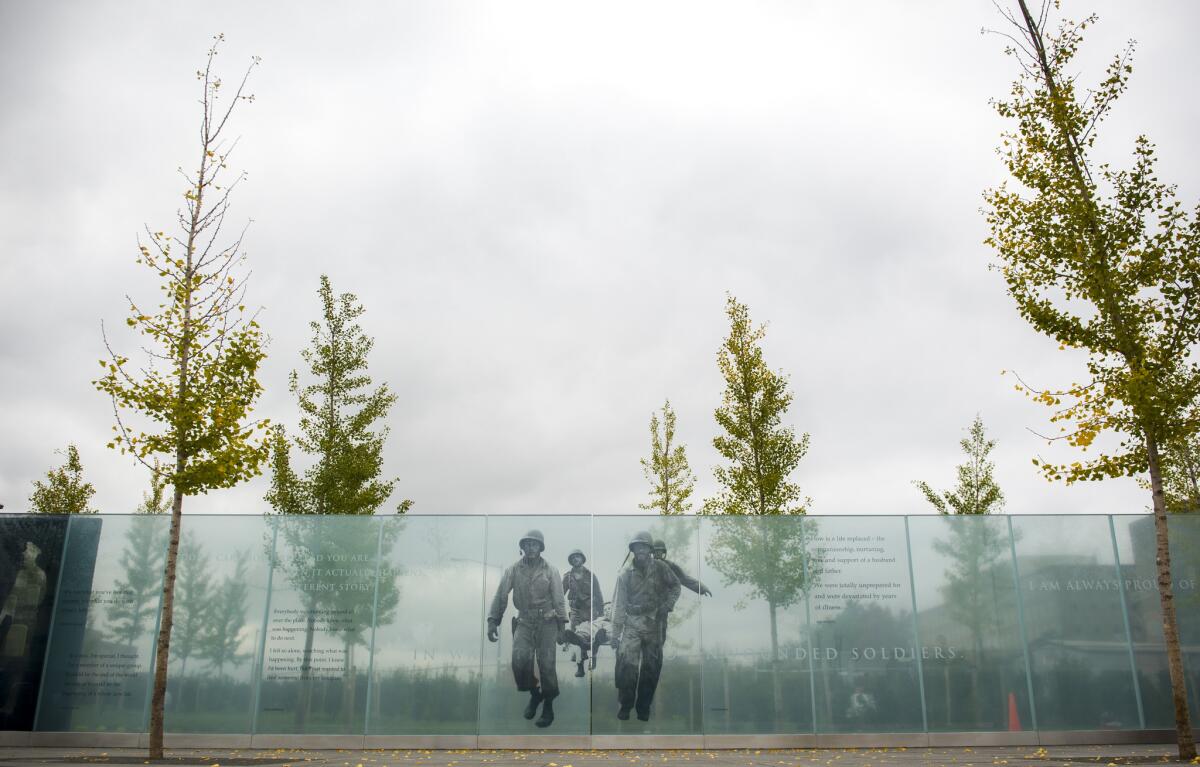Op-Ed: From war to welfare: Disabled veterans deserve better

The Americans Disabled for Life Memorial, located near the capitol in Washington, DC., opened last October.
When American soldiers return home from war with disabilities, they often suffer twice â first from their combat injuries, next from the humiliation of government dependency.
Wounded veterans learn they have two basic choices: They can receive almost $3,000 a month in disability benefits along with medical care and access to various other welfare programs, or they can try to find a job. Especially in this economy, itâs no wonder that many find that first option hard to turn down.
The VA, and others, encourage [veterans] to view themselves as disabled.
— Eric Greitens, Navy SEAL and founder of the nonprofit Mission Continues
Mark Duggan, an economics professor at Stanford University, reports that enrollment in U.S. veteransâ disability programs rose from 2.3 million in 2001 to 3.9 million in 2014. The percentage of veterans receiving benefits doubled, from 8.9% in 2001 to 18% in 2014. Disability services for veterans now consume $59 billion of the $151-billion Department of Veterans Affairs budget.
In the 1980s and 1990s, male veterans were more likely to be in the labor force than nonveterans. But since 2000, that has changed dramatically. Now there is a 4% gap between veteran and nonveteran labor participation, with veteran participation lower.
Navy SEAL Eric Greitens, founder of the Mission Continues, explains how soldiers who served their country are transformed into welfare recipients who live off their country.
âWhen vets come home from war they are going through a tremendous change in identity,â he says. âThen the VA, and others, encourage them to view themselves as disabled.â By the time they come to Greitensâ nonprofit, âWe meet a number of veterans who see themselves as charity cases and are not sure anymore what they have to contribute.â
There are also more tangible factors driving the disability boom. One is the expansion of eligibility criteria. In 2000, for instance, Type 2 diabetes was added as a disability because of evidence linking exposure to Agent Orange with onset of the disease. Heart disease has also been added to
the list.
Another possible factor is that younger veterans seem less averse to welfare than their parentsâ generation. Veterans who have served since the 1990s are much more likely to sign up for disability than their older counterparts; 1 in 4 younger veterans is on disability, versus just 1 in 7 of those over
age 54.
We shouldnât go back to the bad-old days when veterans were afraid to admit weakness. But Lt. Col. Daniel Gade is one of many veterans who think our disability system is harmful, psychologically, to former soldiers. Gade lost his leg in combat in 2005 and now teaches at West Point. He recently gave a talk to disabled veterans at Ft. Carson, Colo., in which he urged them to rejoin the workforce.
âPeople who stay home because they are getting paid enough to get by on disability are worse off,â he warned. âThey are more likely to abuse drugs and alcohol. They are more likely to live alone.â
What a waste of human potential, especially since most veterans on disability still have their prime working years ahead of them when theyâre discharged.
We could redress this problem by changing the way we view â and label â veterans with disabilities. As Gade noted in a recent National Affairs article, âVeterans should be viewed as resources, not as damaged goods.â He recommended that âefforts to help veterans should begin by recognizing their abilities rather than focusing exclusively on their disabilities, and should serve the ultimate aim of moving wounded soldiers ⌠to real self-sufficiency.â
On a more practical note, Veterans Affairs could reallocate resources to spend more on job training and less on disability. Current placement programs are woefully inadequate.
We are good at sending soldiers off to war. Yet when these young men and women return home, they are essentially told, âWeâll give you enough for a reasonably comfortable life, but we wonât help you find a job.â
It is unconscionable that we are condemning thousands of young veterans who served their country to life on the dole rather than enabling them to reenter the workforce with the necessary accommodations.
Phil Harvey and Lisa Conyers are coauthors of âThe Human Cost of Welfare.â
Follow the Opinion section on Twitter @latimesopinion and Facebook
MORE IN OPINION:
Why Ben Carson has no business near the Oval Office
Dayna Bochco, the orca protector
Another delay for anxious immigrant families
More to Read
A cure for the common opinion
Get thought-provoking perspectives with our weekly newsletter.
You may occasionally receive promotional content from the Los Angeles Times.










